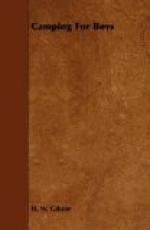In addition to nature study, woodcraft, first-aid instruction and similar types of educational activities in vogue in boy’s camps, there are many other forms of educational activities which boys can engage in during the camping season.
Whittlers’ Club
A “Whittlers’ Club,” organized to meet one hour several mornings a week, proved attractive to a group of boys in one camp. Under the leadership of a man who understood “Sloyd” [1] work the boys were taught how to handle a knife, and it is surprising how few boys really know how to handle this useful article found in every boy’s pocket. They were also taught to know the different kinds of wood, bark, grain, and method of cutting and sawing wood for building and furniture purposes, etc. A popular model was a paper knife made of wild cherry. The bark was permitted to remain on the handle, while the other end was whittled evenly and smoothly for cutting leaves of books or magazines. With the aid of a pyrography set the name of the camp and that of the owner of the knife was burned on the handle.
[Transcriber’s Footnote 1: Manual training developed in Sweden, using woodworking tools.]
Pyrography
Carved paddles, war clubs, hiking sticks, etc., were used to display the artistic ability of the boys who brought to camp pyrography sets. The camp name, date of hikes, miles travelled, and other interesting information was burned on these souvenirs. Shields containing the athletic records and names of honor boys were made and hung upon the walls of the permanent building.
Boat Building
[Illustration: Boat Building at Camp Durrell]
In one large camp an experienced boatman was engaged, and under his direction three large dories were built by the boys. Plans were carefully worked out, lumber purchased, and details of boat construction explicitly explained. It took three weeks to build the boats, but no boats of the fleet were used and appreciated as much by the boys as these which represented so much of their own labor and time. (See illustration.) Working plans and “knocked down” material for building boats may be purchased from a number of firms. Building a boat during the winter by boys who are contemplating going camping, aids to the anticipation of the delightful summer time.
[Illustration: “Pyramus and Thisbe,” Players Scene from Midsummer Night’s Dream; Camp Becket]
Plays
“The Player’s Scene,” from “Midsummer Night’s Dream,” has been given several times outdoors with great success in the camps conducted by the writer. The boys were coached by a graduate of a School of Oratory, costumes were made by the boys out of all sorts of material, make-up was bought from a theatrical supply house and the scenery supplied by nature. Footlights were lanterns set in front of reflectors made from old tomato cans. The path leading to the natural amphitheatre was lighted by Japanese lanterns and the guests were seated on the ground. In the words of Hamlet, “The Play’s the Thing,” and boys and visitors are always enthusiastic over the presentation, while the players get a new conception of Shakespeare’s plays and writings. “Hiawatha” was given with equal enthusiasm and success.




